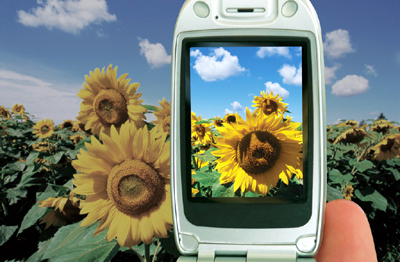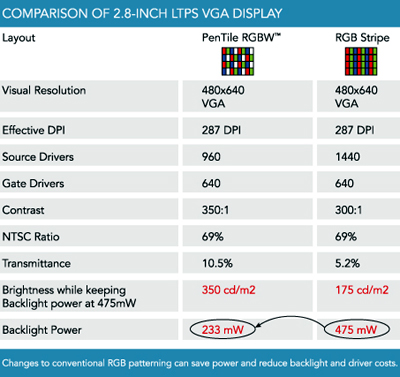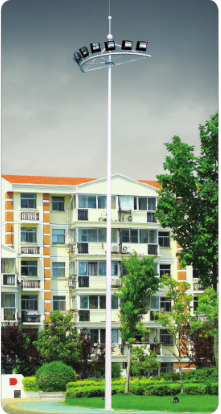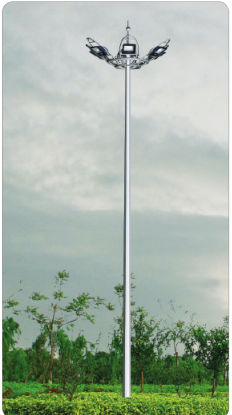Mobile phones have quickly evolved from a simple phone to a sophisticated device that lets users share photos, email access, play games, surf the web, and find restaurants that they like. The impact on hardware devices is a more even division of power usage between RF, LCD, and application processors, a dramatic shift from the system dominated by RF/processors used in traditional single-function cellular phones.
This article refers to the address: http://
For design engineers, the latest application challenge is a new generation of phones or portable devices that can play video and TV shows. These applications present a paradoxical challenge because they not only consume more power, but also require more brightness to achieve the desired display, which in turn requires more power. This design requirement further hinders engineers from effectively balancing performance and power requirements while controlling overall equipment costs.
Mobile video display requirements
The display industry has long recognized that current display technologies cannot meet the power requirements of next-generation devices without hindering the adoption of new technologies, and should focus more on finding and optimizing performance by modifying the display. More power-consuming methods. This is often achieved by simply reducing backlight power consumption, sacrificing brightness but still delivering good performance for most existing applications. However, with the advent of mobile TV, the need for more eye-catching brightness has become increasingly prominent, adding new factors to the challenge between power consumption/performance.
Unless the brightness is high enough, video-enabled devices will not satisfy consumers who want to see all the details and images on the screen. Many of the small displays currently on the market that are designed into cellular phones or portable devices exhibit an average brightness of 200 nits. However, in order to look at the detailed details of the mobile TV content or watch the video with great satisfaction, it is urgent to increase the brightness level by 2 to 3 times to 400 nits or higher, which is close to the brightness of a home television set.

Figure 1: 250 nit display

Figure 2: 500 nit display
Although the role of brightness has long been recognized, it is not widely used in handheld products because battery life is insufficient to support such high brightness display.
Let us imagine, for example, that a kayaker image being displayed on a typical 250 nit display (Fig. 1) is compared to a display with a brightness of 500 or 600 nits (Fig. 2) suitable for viewing mobile TV. Video applications require brightness of approximately 400 nits or more, resulting in at least a 2x increase in display backlight brightness.
Next generation PenTile RGBW technology
With this simple comparison, it is clear that the brightness standard must be increased to accommodate the requirements of mobile video applications, which also means that the power consumption of the device is correspondingly reduced. An improvement of 2X (times) to 3X in backlight brightness conversion means an increase of 2X to 3X power consumption. And because mobile video applications extend the life of the backlight, it consumes 90% of the power in the display, and turning off the backlight is not desirable, which further exacerbates the power control problem of mobile devices.
In addition, there are other reasons that make mobile video consume more power. Unlike still images, video requires a longer period of browsing, and it also requires MPEG decompression. Even the most efficient microcontroller (MCU) consumes more power when processing MPEG than it does for other tasks. Perhaps the most important factor in the increase in power demand comes from the recognition of the brightness requirements of the video display. Unlike text, calendar, and even web browser applications, video requires a wider range of brightness to complement the large dynamic range of changes from outdoor sports to indoors and even nighttime scenes.
Similarly, the trend toward video-enabled mobile phones is toward the availability of video graphics array (VGA) solutions, 262K to 16M colors, and the color gamut is 100% close to the colorful display screens of the National Television System Committee (NTSC). In addition, since the wideband reduces the number of horizontal scrolls for viewing the entire image on the screen, the widescreen format is also being used to watch videos and play games or browse web pages in the original format. All of these demands increase power consumption, especially in backlights, which can increase the power budget by as much as 250mW.
Component manufacturers are working on potential solutions including: developing new display technologies; using brightness enhancements in LCDs or backlights; or transflective LCDs, OLEDs or other new types that offer greater brightness. Design combined. In addition, much work is being done to improve battery technology. However, these revolutionary measures do not meet the requirements for brightness, resolution, and low power consumption required to view mobile video; and in some cases, cost constraints due to the additional manufacturing costs involved.
PenTile RGBW display technology
Developed by human visual pioneer Clairvoyante, PenTile RGBW technology achieves higher brightness levels without reducing resolution or increasing power consumption in data center equipment.
The PenTile technique adds a white sub-pixel to a traditional RGB stripe arrangement consisting of red, yellow, and blue colors, and then applies the corresponding sub-pixel imaging technique to those sub-pixels in a way that humans see the image. Make a better alignment. This ensures that images that are not visible to the human eye are generated without loss of display power and brightness.

Figure 3: Subpixel imaging enables the display to achieve nearly double white brightness or reduce power consumption by up to 50%.
To achieve a better alignment with human vision, the PenTile sub-pixel imaging technique individually addresses each sub-pixel. It reduces the overall number of sub-pixels but increases the size of the individual, and adds a white (clear) sub-pixel to the permutation mode to form an RGBW pixel design that is more traditional than the traditional RGB stripe display. Brighter and higher resolution. Since more backlights can be illuminated by larger and semi-transparent sub-pixels instead of the tight alignment of smaller red, green, and blue sub-pixels used by RGB stripes, both transmittance and brightness are obtained. Increased. Since the larger the sub-pixels, the larger the aperture ratio, and the use of white sub-pixels, nearly twice the increase in white luminance is achieved without an increase in power consumption. PenTile technology integration selectively doubles power efficiency and saves material costs by reducing the number of resource drivers and reducing the number of backlight LEDs required for a particular brightness output level.
Processed with PenTile RGBW technology
Since a large amount of power consumption is consumed by the backlight and still less than 5% of the LCD transmittance, there are few ways to significantly improve the efficacy of the handheld display. Perhaps the biggest benefit in terms of efficiency is toward a higher aperture ratio display, which may be related to advances in amorphous silicon (aSi) thin film transistors (TFTs) or even low temperature polysilicon (LTPS) technology by using Clairvoyante's PenTile RGBW. Technology, their superiority can be further transformed into capital.
As shown below, unlike traditional RGB LCDs, PenTile technology utilizes different arrangements of multiple color filters. As shown below, one can write a white point to a PenTile RGBW display to compare it to a regular RGB stripe display.
When writing the finest pattern consisting of black and white lines, the full period of a black line and a white line appears in contrast to the RGB stripe (see Figure 4). Note that for the PenTile RGBW display, four columns are required to write a pair, and for RGB stripes, six columns are required. This makes the column in the PenTile display 1/3 wider, which increases the aperture ratio and allows more light to pass through.
The increased aperture ratio combined with the greater transmittance provided by the clear sub-pixels, which would not be considered for the backplane technique, would normally pass through a 2.4 to 8.8 inch diagonal diagonal VGA display. The light transmittance is doubled.

Figure 4: PenTile RGBW mode (a) requires fewer columns per pixel than RGB Stripe mode (b), but is economically and functionally superior.
The firmware shown in the figure below, PenTile RGBW processing is divided into several steps. The first step is to convert the RGB input data to RGBW by adjusting the data for each display transfer curve (gamma) of a particular display in the input lookup table (LUT) using Clairvoyante's corresponding color gamut algorithm (GMA). Clairvoyante uses this as an input color gamut for reference. After applying GMA to a white pixel processing block, it is necessary to apply subpixel rendering algorithms that take advantage of the mathematical form of multiple matrices. At this time, matrix algebra is particularly important and should be applied to the pixels of a 3x3 matrix. Clairvoyante's IC utilizes a memory buffer for two data lines so that the third data line can be manipulated as it enters the chip, allowing continuous processing of pixels in the 3x3 matrix. After sub-pixel imaging, the gamma adjustment is cancelled to ensure that the display curve of the display is accurately applied to the new sub-pixels produced by the RGBW data.

Figure 5: Programming the registers
Video processing is almost the same as still image and stylistic processing. This is because hardware matrix processing is very effective. There is only one line delay when processing video. This delay is almost imperceptible to the viewer.
Next: Comparison of 2.8-inch LTPS display
Some display manufacturers have studied PenTile sub-pixel imaging technology and found that it can significantly improve the performance of the display in terms of brightness, resolution and power consumption, which is a practical solution. In addition, manufacturers recognize that these enhancements are not only amorphous but also LTPS and OLED displays.
For example, by employing sub-pixel imaging processing techniques with LTPS, the number of drivers reduces RGB stripe by a factor of 1/3 without affecting visual resolution. This improvement reduces the number of backlight LEDs without reducing brightness and provides more space for components like LCD power supplies to be integrated into the glass. Only these factors can save LTPS's power consumption by half. This technology can save up to 250mW in the LTPS VGA display or 100mW in the QVGA display.

Figure 6: A comparative study based on AU Optronics specifications: two 2.8-inch LTPS VGA displays, one with PenTile technology and one without this.
Future mobile phones with video capabilities will be more pleasing
Several research companies, including iSuppli, predict that the video-enabled mobile phone market will increase from $700 million in 2005 to $2.2 billion in 2010, and the revenue from video will be $550 million. Increased to $14 billion. The early adopters have surpassed the popularity of mobile TV driven by the new Internet transmission model and have achieved great success. OEM manufacturers are working hard to meet the expected needs of video phones.
The mobile TV experience is improved with a specially optimized display that allows engineers to take advantage of the greater design flexibility offered by display technologies such as the PenTile RGBW design. Performance tradeoffs are no longer important and can give mobile phones a competitive edge. the price of. As a result, these devices can easily meet customer requirements, create demand and drive sales with higher visual performance and longer battery life.
The High-mast Lamp is generally refers to the new lighting device which is composed of the steel taper light pole and the high power combination lamp frame of 15 meters or above.It consists of lamp holder, internal lamp, electric rod body and basic part.Lamp head modelling can according to user requirement, surroundings, lighting need specific and definite;The interior lamps are mainly composed of floodlights and projection lamps. The light source adopts NG400 high pressure sodium lamp, and the lighting radius is 60 meters.The bar body is usually a pyramid structure, which is made of steel plate, with a height of 15 to 40 meters, which consists of two to three sections.


Material characteristics
1. Beautiful appearance, large lighting area, good lighting effect, concentrated light, uniform illumination, small glare and easy to control and repair.
2. Applicable places: city square, station, wharf, highway, stadium, overpass, etc.
3. The lamp pole is a high quality steel plate by moulding into a multi - pyramid splicing steel rod, through hot galvanizing anti-corrosion treatment.
4. The lamp frame is made of high quality stainless steel.
5. Fasteners bolts and nuts are stainless steel.
6. Light source:400W-1000W sodium lamp.
Specifications:
Height: from 18m to 50 m
Suit for: highway, expressway, parkway, freeway, central motorway junction, truck and bus terminals, railyards, ship docks, airports, ferry terminals, prisons, industrial and commercial sites, international borders.
Shape: round, multi-pyramidal, column form, polygonal or conical
Material:
Q345B/A572,minimum yield strength>=345n/mm2
Q235B/A36,minimum yield strength>=235n/mm2
Tolerance of Dimension: ±2%
Lighting Source: 400 W- 5000 W high pressure sodium flood light, light extension :up to 30 000 m²
Light plate: Various figure of selection ,material with hot dip galvanization steel frame
Lifting System: Lifter fixed in the inner of the pole with lifting speed of 3~5 meter per minute
Equipped e; ant ferromagnetism brake and break -proof device, manual operation applied under power cut
Electric Appliance Control Device: Electric appliance box to be the hold of the pole ,lifting operation could be 5 meter away from the pole through wire .Time control and light control could be equipped to realize full-load lighting mode and part lighting mode
Surface treatment: Hot dip galvanized Following ASTM A 123, color polyester power or any other standard by client required.
Joint of Poles: Insert mode, inner flange mode, face to face joint mode .
Design of pole: Against earthquake of 8 grade
Wind Speed: 80 Km/Hour
Welding: We has past flaw testing. Internal and external double welding makes the welding in shape
Thickness: 6 mm to 20 mm
Production Process:
Raw material test→Cutting→Molding or bending →Welding (longitudinal ) →Dimension verify→Flangewelding→Hole drilling →Calibration →Deburr →Galvanization or powder coating, Painting→Recalibration→Thread→Packaging
Packages: Our poles as normal cover by Mat or straw bale at the top and bottom ,anyway also can following by client required
High-Mast Lamps Series,High Mast Lamps,High Mast Light,High Mast Light Pole
Jiangsu chengxu Electric Group Co., Ltd , https://www.satislighting.com